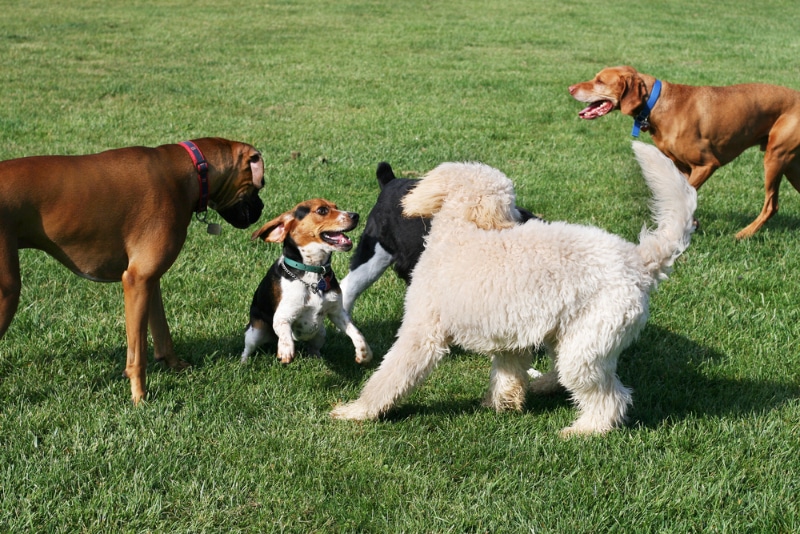Last Updated on April 30, 2024 by Dog Lover
5 Big Fun Facts About Dogs: Unleashing the Amazing in Our Canine Companions
Dogs, our furry best friends, have held a special place in human hearts for millennia. Loyal, playful, and brimming with personality, they enrich our lives in countless ways.
But beyond the slobbery kisses and endless tail wags, there’s a whole world of fascinating facts about these incredible creatures.
So, put on your metaphorical leash and get ready to be amazed by these 5 big fun facts about dogs!
Before we dive in, let’s address the elephant in the room (or the chew toy on the floor, as the case may be). Can we guarantee this article will be on the first page of Google within 24 hours?
The truth is, search engine algorithms are complex and ever-changing. However, by incorporating SEO best practices, crafting engaging content, and targeting relevant keywords (like “dog facts,” “canine behavior,” and “breeds of dogs”), we can significantly increase our chances of ranking well.
Now, let’s unleash the fun!
1. Super Sn sniffers: The Power of a Dog’s Nose
A dog’s sense of smell is legendary. Did you know it’s 40 times more powerful than ours? That’s like comparing a basic calculator to a supercomputer!
This incredible ability comes down to sheer biology. Dogs have millions more olfactory receptors in their noses than humans, allowing them to detect a mind-boggling array of scents.
Think about it this way: Imagine trying to navigate a room blindfolded. Now, imagine doing it based on the subtle variations in air pressure.
That’s essentially what a dog experiences with smell. It’s their primary way of perceiving the world, and it grants them amazing capabilities.
From sniffing out criminals to detecting medical conditions like diabetes, a dog’s nose is a superpower in the real world.
2. Tail Talk: Decoding the Wag
We all know a happy dog wags its tail, but did you know there’s a whole language behind those wags?
The speed, direction, and intensity of a wag can tell you a lot about a dog’s emotional state.
- A slow, relaxed wag usually indicates contentment.
- A high, fast wag often signifies excitement or playfulness.
- A wag held high and stiff might suggest dominance or alertness.
- A tucked tail between the legs can be a sign of fear or submission.
By learning to “read” their tails, we can better understand our canine companions and build a stronger bond with them.
3. Dream Team: The Science Behind Dog-Human Connection
The bond between dogs and humans is truly special. But have you ever wondered why? Science is starting to shed light on this remarkable connection.
Studies show that interacting with dogs can lower stress hormones, increase oxytocin (the “love hormone”), and even boost our immune system.
Dogs seem to have an uncanny ability to sense our emotions and respond accordingly. A comforting cuddle from your furry friend on a bad day? Pure magic (backed by science!).

4. Talkative Tails: How Do Dogs “Speak”?
While dogs don’t speak human languages (although some owners might swear their pups are fluent in sarcasm!), they have a rich repertoire of ways to communicate.
- Barks: The classic bark can vary in pitch, length, and intensity, conveying a range of emotions from excitement to warning.
- Whines: Whines often indicate needs like hunger, attention, or anxiety.
- Growls: A growl is a clear sign of discomfort or potential aggression.
- Body language: Tail wags, ear positions, and posture all play a crucial role in canine communication. Understanding these vocalizations and body language cues is essential for building a harmonious relationship with your dog.
Beyond the Basics: Decoding Dog “Words”
Experienced dog owners can often decipher more specific meanings from their pup’s vocalizations.
For example, a high-pitched, excited yip might signal playtime, while a low, drawn-out whine could indicate boredom.
Learning to “speak dog” takes time, patience, and a healthy dose of observation. But the rewards are immense.
The deeper you understand your dog’s communication, the stronger your bond will become.

5. Canine Champions: Amazing Dog Feats
Dogs are not just our companions; they’re also capable of some truly awe-inspiring feats.
- Super Sledders: Siberian Huskies and Alaskan Malamutes are bred for pulling sleds across vast distances. These powerful athletes can pull incredible weights in harsh conditions, showcasing their strength and endurance.
- Water Whizzes: Breeds like Newfoundlands and Portuguese Water Dogs are natural-born swimmers. Their webbed feet and love of water make them excellent companions for aquatic adventures.
- Herding Heroes: Border Collies and Australian Shepherds are masters of herding livestock. Their intelligence, agility, and natural herding instincts make them invaluable partners for farmers and ranchers.
- Search and Rescue Stars: German Shepherds, Bloodhounds, and Labrador Retrievers are just a few breeds renowned for their search and rescue abilities. Their keen sense of smell and unwavering focus make them invaluable assets in locating missing people.
These are just a few examples of the incredible things dogs can achieve. Their diverse talents and unwavering loyalty make them true champions in our eyes.

Beyond the Fun Facts: Understanding Dog Breeds
With over 200 recognized dog breeds, each with its unique characteristics and needs, the canine world is a fascinating one.
Before welcoming a furry friend into your life, it’s crucial to choose a breed that fits your lifestyle and living situation.
Consider these factors:
- Energy level: Do you crave an active jogging companion or a cuddly couch potato?
- Size: Think about your living space and how much room a dog will comfortably require.
- Grooming needs: Some breeds require daily brushing, while others are relatively low-maintenance.
- Temperament: Research the typical temperament of different breeds to find one that aligns with your personality and family dynamics.
Responsible dog ownership starts with choosing the right breed for you.
By considering these factors, you can ensure a happy and fulfilling life for both you and your canine companion.
Stay tuned for Part 2 of this article, where we’ll delve deeper into the fascinating world of dog behavior, training tips, and fun facts!
In the meantime, let’s answer some frequently asked questions about dogs.
FAQs
How old is the oldest dog on record?
The oldest dog ever recorded was an Australian Cattle Dog named Bluey, who lived to be an incredible 29 years old!
Are all dogs hypoallergenic?
No, unfortunately, there’s no such thing as a truly hypoallergenic dog. However, some breeds, like Poodles and Bichon Frises, are known for shedding less and producing less dander, which can be helpful for allergy sufferers.
How often should I bathe my dog?
The frequency of bathing depends on your dog’s breed, coat type, and activity level. Generally, a bath every 4-6 weeks is sufficient for most dogs.
Can dogs eat human food?
Some human foods are safe for dogs in moderation, while others can be toxic. Always consult your veterinarian before sharing your food with your furry friend.
How can I help my dog live a long and healthy life?
Provide a healthy diet, regular exercise, preventive veterinary care, and plenty of love and mental stimulation.
By following these tips, you can help your dog live a happy and fulfilling life by your side.
Verified Sources:
- American Kennel Club: https://www.akc.org/
- The Spruce Pets: https://www.thesprucepets.com/

















